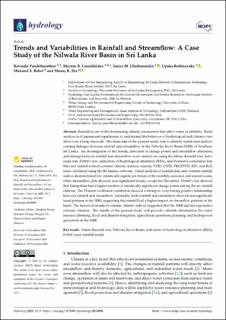| dc.description.abstract | Rainfall is one of the dominating climatic parameters that affect water availability. Trend analysis is of paramount significance to understand the behavior of hydrological and climatic variables over a long timescale. The main aim of the present study was to identify trends and analyze existing linkages between rainfall and streamflow in the Nilwala River Basin (NRB) of Southern Sri Lanka. An investigation of the trends, detection of change points and streamflow alteration, and linkage between rainfall and streamflow were carried out using the Mann–Kendall test, Sen’s slope test, Pettitt’s test, indicators of hydrological alteration (IHA), and Pearson’s correlation test. Selected rainfall-related extreme climatic indices, namely, CDD, CWD, PRCPTOT, R25, and Rx5, were calculated using the RClimdex software. Trend analysis of rainfall data and extreme rainfall indices demonstrated few statistically significant trends at the monthly, seasonal, and annual scales, while streamflow data showed non-significant trends, except for December. Pettitt’s test showed that Dampahala had a higher number of statistically significant change points among the six rainfall stations. The Pearson coefficient correlation showed a strong-to–very-strong positive relationship between rainfall and streamflow. Generally, both rainfall and streamflow showed non-significant trend patterns in the NRB, suggesting that rainfall had a higher impact on streamflow patterns in the basin. The historical trends of extreme climatic indices suggested that the NRB did not experience extreme climates. The results of the present study will provide valuable information for water resource planning, flood and disaster mitigation, agricultural operations planning, and hydropower generation in the NRB. | en_US |

